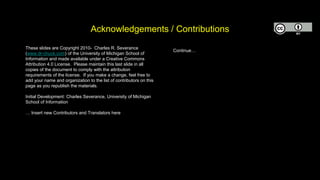Pythonlearn-01-Intro.pptx
- 1. Why Program? Chapter 1 Python for Everybody www.py4e.com
- 2. Computers Want to be Helpful... • Computers are built for one purpose - to do things for us • But we need to speak their language to describe what we want done • Users have it easy - someone already put many different programs (instructions) into the computer and users just pick the ones they want to use What Next? What Next? What Next? What Next? What Next? What Next? What Next?
- 3. Programmers Anticipate Needs • iPhone applications are a market • iPhone applications have over 3 billion downloads • Programmers have left their jobs to be full-time iPhone developers • Programmers know the ways of the program Pick Me! Pick Me! Pick Me! Pick Me! Pay Me! Pick Me!
- 4. Users vs. Programmers • Users see computers as a set of tools - word processor, spreadsheet, map, to-do list, etc. • Programmers learn the computer “ways” and the computer language • Programmers have some tools that allow them to build new tools • Programmers sometimes write tools for lots of users and sometimes programmers write little “helpers” for themselves to automate a task
- 5. Why be a Programmer? • To get some task done - we are the user and programmer - Clean up survey data • To produce something for others to use - a programming job - Fix a performance problem in the Sakai software - Add a guestbook to a web site
- 6. Computer Hardware + Software Networks .... From a software creator’s point of view, we build the software. The end users (stakeholders/actors) are our masters - who we want to please - often they pay us money when they are pleased. But the data, information, and networks are our problem to solve on their behalf. The hardware and software are our friends and allies in this quest. Information Data User Programmer
- 7. What is Code? Software? A Program? • A sequence of stored instructions - It is a little piece of our intelligence in the computer - We figure something out and then we encode it and then give it to someone else to save them the time and energy of figuring it out • A piece of creative art - particularly when we do a good job on user experience
- 9. Programs for Humans... while music is playing: Left hand out and up Right hand out and up Flip Left hand Flip Right hand Left hand to right shoulder Right hand to left shoulder Left hand to back of head Right ham to back of head Left hand to right hit Right hand to left hit Left hand on left bottom Right hand on right bottom Wiggle Wiggle Jump https://www.youtube.com/watch?v=XiBYM6g8Tck
- 10. Programs for Humans... while music is playing: Left hand out and up Right hand out and up Flip Left hand Flip Right hand Left hand to right shoulder Right hand to left shoulder Left hand to back of head Right ham to back of head Left hand to right hit Right hand to left hit Left hand on left bottom Right hand on right bottom Wiggle Wiggle Jump https://www.youtube.com/watch?v=XiBYM6g8Tck
- 11. Programs for Humans... while music is playing: Left hand out and up Right hand out and up Flip Left hand Flip Right hand Left hand to right shoulder Right hand to left shoulder Left hand to back of head Right hand to back of head Left hand to right hip Right hand to left hip Left hand on left bottom Right hand on right bottom Wiggle Wiggle Jump https://www.youtube.com/watch?v=XiBYM6g8Tck
- 12. the clown ran after the car and the car ran into the tent and the tent fell down on the clown and the car Programs for Python... Image: https://www.flickr.com/photos/allan_harris/4908070612/ Attribution-NoDerivs 2.0 Generic (CC BY-ND 2.0)
- 13. Programs for Python... Image: https://www.flickr.com/photos/allan_harris/4908070612/ Attribution-NoDerivs 2.0 Generic (CC BY-ND 2.0)
- 14. name = input('Enter file:') handle = open(name) counts = dict() for line in handle: words = line.split() for word in words: counts[word] = counts.get(word,0) + 1 bigcount = None bigword = None for word,count in counts.items(): if bigcount is None or count > bigcount: bigword = word bigcount = count print(bigword, bigcount) python words.py Enter file: words.txt to 16 python words.py Enter file: clown.txt the 7
- 18. Definitions • Central Processing Unit: Runs the Program - The CPU is always wondering “what to do next”. Not the brains exactly - very dumb but very very fast • Input Devices: Keyboard, Mouse, Touch Screen • Output Devices: Screen, Speakers, Printer, DVD Burner • Main Memory: Fast small temporary storage - lost on reboot - aka RAM • Secondary Memory: Slower large permanent storage - lasts until deleted - disk drive / memory stick What Next?
- 22. Hard Disk in Action http://www.youtube.com/watch?v=9eMWG3fwiEU
- 23. Python as a Language
- 24. http://harrypotter.wikia.com/wiki/Parseltongue Parseltongue is the language of serpents and those who can converse with them. An individual who can speak Parseltongue is known as a Parselmouth. It is a very uncommon skill, and may be hereditary. Nearly all known Parselmouths are descended from Salazar Slytherin.
- 25. Python is the language of the Python Interpreter and those who can converse with it. An individual who can speak Python is known as a Pythonista. It is a very uncommon skill, and may be hereditary. Nearly all known Pythonistas use software initially developed by Guido van Rossum.
- 26. Early Learner: Syntax Errors • We need to learn the Python language so we can communicate our instructions to Python. In the beginning we will make lots of mistakes and speak gibberish like small children. • When you make a mistake, the computer does not think you are “cute”. It says “syntax error” - given that it knows the language and you are just learning it. It seems like Python is cruel and unfeeling. • You must remember that you are intelligent and can learn. The computer is simple and very fast, but cannot learn. So it is easier for you to learn Python than for the computer to learn English...
- 28. csev$ python3 Python 3.5.1 (v3.5.1:37a07cee5969, Dec 5 2015, 21:12:44) [GCC 4.2.1 (Apple Inc. build 5666) (dot 3)] on darwinType "help", "copyright", "credits" or "license" for more information. >>> What next?
- 29. csev$ python3 Python 3.5.1 (v3.5.1:37a07cee5969, Dec 5 2015, 21:12:44) [GCC 4.2.1 (Apple Inc. build 5666) (dot 3)] on darwinType "help", "copyright", "credits" or "license" for more information. >>> x = 1 >>> print(x) 1 >>> x = x + 1 >>> print(x) 2 >>> exit() This is a good test to make sure that you have Python correctly installed. Note that quit() also works to end the interactive session.
- 30. What Do We Say?
- 31. Elements of Python • Vocabulary / Words - Variables and Reserved words (Chapter 2) • Sentence structure - valid syntax patterns (Chapters 3-5) • Story structure - constructing a program for a purpose
- 32. name = input('Enter file:') handle = open(name) counts = dict() for line in handle: words = line.split() for word in words: counts[word] = counts.get(word,0) + 1 bigcount = None bigword = None for word,count in counts.items(): if bigcount is None or count > bigcount: bigword = word bigcount = count print(bigword, bigcount) python words.py Enter file: words.txt to 16 A short “story” about how to count words in a file in Python
- 33. Reserved Words You cannot use reserved words as variable names / identifiers False class return is finally None if for lambda continue True def from while nonlocal and del global not with as elif try or yield assert else import pass break except in raise
- 34. Sentences or Lines x = 2 x = x + 2 print(x) Variable Operator Constant Function Assignment statement Assignment with expression Print statement
- 36. Python Scripts • Interactive Python is good for experiments and programs of 3-4 lines long. • Most programs are much longer, so we type them into a file and tell Python to run the commands in the file. • In a sense, we are “giving Python a script”. • As a convention, we add “.py” as the suffix on the end of these files to indicate they contain Python.
- 37. Interactive versus Script • Interactive - You type directly to Python one line at a time and it responds • Script - You enter a sequence of statements (lines) into a file using a text editor and tell Python to execute the statements in the file
- 38. Program Steps or Program Flow • Like a recipe or installation instructions, a program is a sequence of steps to be done in order. • Some steps are conditional - they may be skipped. • Sometimes a step or group of steps is to be repeated. • Sometimes we store a set of steps to be used over and over as needed several places throughout the program (Chapter 4).
- 39. Sequential Steps Program: x = 2 print(x) x = x + 2 print(x) Output: 2 4 x = 2 print(x) x = x + 2 print(x) When a program is running, it flows from one step to the next. As programmers, we set up “paths” for the program to follow.
- 40. Conditional Steps Output: Smaller Finis Program: x = 5 if x < 10: print('Smaller') if x > 20: print('Bigger') print('Finis') x = 5 x < 10 ? print('Smaller') x > 20 ? print('Bigger') print('Finis') Yes No No Yes
- 41. Repeated Steps Output: 5 4 3 2 1 Blastoff! Program: n = 5 while n > 0 : print(n) n = n – 1 print('Blastoff!') n > 0 ? Loops (repeated steps) have iteration variables that change each time through a loop. No print('Blastoff') Yes n = 5 print(n) n = n -1
- 42. name = input('Enter file:') handle = open(name, 'r') counts = dict() for line in handle: words = line.split() for word in words: counts[word] = counts.get(word,0) + 1 bigcount = None bigword = None for word,count in counts.items(): if bigcount is None or count > bigcount: bigword = word bigcount = count print(bigword, bigcount) Sequential Repeated Conditional
- 43. name = input('Enter file:') handle = open(name, 'r') counts = dict() for line in handle: words = line.split() for word in words: counts[word] = counts.get(word,0) + 1 bigcount = None bigword = None for word,count in counts.items(): if bigcount is None or count > bigcount: bigword = word bigcount = count print(bigword, bigcount) A short Python “Story” about how to count words in a file A word used to read data from a user A sentence about updating one of the many counts A paragraph about how to find the largest item in a list
- 44. Summary • This is a quick overview of Chapter 1 • We will revisit these concepts throughout the course • Focus on the big picture
- 45. Acknowledgements / Contributions These slides are Copyright 2010- Charles R. Severance (www.dr-chuck.com) of the University of Michigan School of Information and made available under a Creative Commons Attribution 4.0 License. Please maintain this last slide in all copies of the document to comply with the attribution requirements of the license. If you make a change, feel free to add your name and organization to the list of contributors on this page as you republish the materials. Initial Development: Charles Severance, University of Michigan School of Information … Insert new Contributors and Translators here Continue…
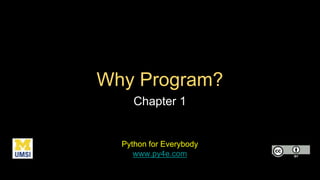





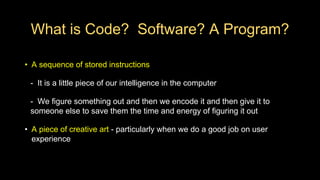

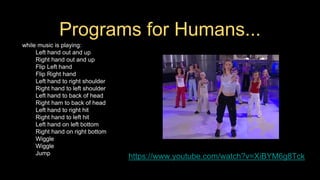
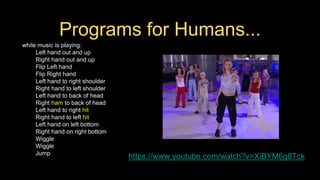



![name = input('Enter file:')
handle = open(name)
counts = dict()
for line in handle:
words = line.split()
for word in words:
counts[word] = counts.get(word,0) + 1
bigcount = None
bigword = None
for word,count in counts.items():
if bigcount is None or count > bigcount:
bigword = word
bigcount = count
print(bigword, bigcount)
python words.py
Enter file: words.txt
to 16
python words.py
Enter file: clown.txt
the 7](https://image.slidesharecdn.com/pythonlearn-01-intro-221219202751-0f0ba833/85/Pythonlearn-01-Intro-pptx-14-320.jpg)



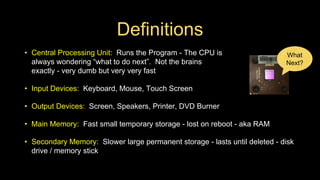









![csev$ python3
Python 3.5.1 (v3.5.1:37a07cee5969, Dec 5 2015, 21:12:44)
[GCC 4.2.1 (Apple Inc. build 5666) (dot 3)] on darwinType
"help", "copyright", "credits" or "license" for more information.
>>>
What
next?](https://image.slidesharecdn.com/pythonlearn-01-intro-221219202751-0f0ba833/85/Pythonlearn-01-Intro-pptx-28-320.jpg)
![csev$ python3
Python 3.5.1 (v3.5.1:37a07cee5969, Dec 5 2015, 21:12:44)
[GCC 4.2.1 (Apple Inc. build 5666) (dot 3)] on darwinType
"help", "copyright", "credits" or "license" for more information.
>>> x = 1
>>> print(x)
1
>>> x = x + 1
>>> print(x)
2
>>> exit()
This is a good test to make sure that you have
Python correctly installed. Note that quit() also
works to end the interactive session.](https://image.slidesharecdn.com/pythonlearn-01-intro-221219202751-0f0ba833/85/Pythonlearn-01-Intro-pptx-29-320.jpg)


![name = input('Enter file:')
handle = open(name)
counts = dict()
for line in handle:
words = line.split()
for word in words:
counts[word] = counts.get(word,0) + 1
bigcount = None
bigword = None
for word,count in counts.items():
if bigcount is None or count > bigcount:
bigword = word
bigcount = count
print(bigword, bigcount)
python words.py
Enter file: words.txt
to 16
A short “story”
about how to count
words in a file in
Python](https://image.slidesharecdn.com/pythonlearn-01-intro-221219202751-0f0ba833/85/Pythonlearn-01-Intro-pptx-32-320.jpg)



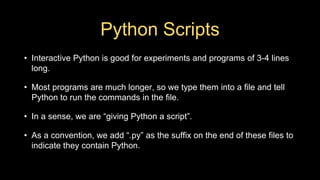
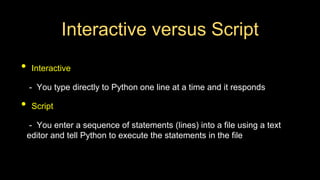


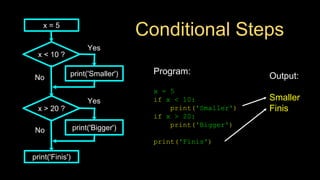

![name = input('Enter file:')
handle = open(name, 'r')
counts = dict()
for line in handle:
words = line.split()
for word in words:
counts[word] = counts.get(word,0) + 1
bigcount = None
bigword = None
for word,count in counts.items():
if bigcount is None or count > bigcount:
bigword = word
bigcount = count
print(bigword, bigcount)
Sequential
Repeated
Conditional](https://image.slidesharecdn.com/pythonlearn-01-intro-221219202751-0f0ba833/85/Pythonlearn-01-Intro-pptx-42-320.jpg)
![name = input('Enter file:')
handle = open(name, 'r')
counts = dict()
for line in handle:
words = line.split()
for word in words:
counts[word] = counts.get(word,0) + 1
bigcount = None
bigword = None
for word,count in counts.items():
if bigcount is None or count > bigcount:
bigword = word
bigcount = count
print(bigword, bigcount)
A short Python “Story”
about how to count
words in a file
A word used to read
data from a user
A sentence about
updating one of the
many counts
A paragraph about how
to find the largest item
in a list](https://image.slidesharecdn.com/pythonlearn-01-intro-221219202751-0f0ba833/85/Pythonlearn-01-Intro-pptx-43-320.jpg)

